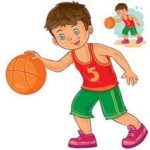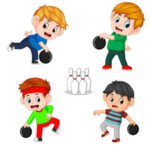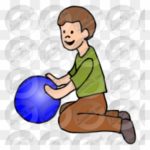
by Santosh | Jun 18, 2020 | Soccer, Sports
LEARNING OUTCOME
To improve dribbling technique
TEACHING CUES
- What part of the boot to use
- How to shield the ball from opposition
- Encourage players to increase tempo
- Players encouraged to use both feet
ACTIVITY SET-UP AND PROCEDURE
EQUIPMENT:
Marked area, 1 ball for each player, cones and slalom poles.
SET-UP:

ACTIVITY PROCEDURES:
- Players dribble from the starting point through the cone gates, round the top cone
- Then in and out of the line of cones.
- Keeping the ball close under control.
- Continuous practice.
Progressions:
- Players to use weaker foot only
- Make the distance between the cones smaller or larger
- Add defender instead of top cone
- Players to go opposite way around activity
COOL DOWN/ CLOSURE
Review Skill/Activity, stretching, and questions.
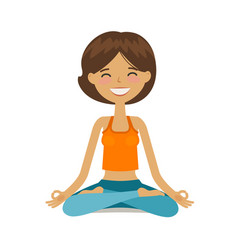
by Neetu | Jun 18, 2020 | Fitness Activity
Posture: Padma-asana – The Lotus Posture (Pronunciation: pud-mah-sa-na)
Description:
The Sanskrit word naga means snake or serpent. The naga-asana is also known as the bhujanga-asana. The Sanskrit word bhujanga, which also means snake, is derived from the root Bhuj which means to bend or curve.
Performing Instructions
- Sit on the floor with the legs stretched out straight in front.
- Bend the right knee and grasp the right foot with both hands and place it on top of the left thigh bringing the heel as close to the navel as possible.
- Bend the left knee and grasp the left foot with both hands and place it on top of the right thigh bringing the heel as close to the navel as possible.
- Both knees should be on the ground and the soles of the feet are pointed upward. The spine is held straight but not rigid.
- The position of the legs may be switched after a period of time if the posture becomes uncomfortable.
Comments:
When in the Padma-asana the hands can be placed in one of the following three positions:
- Place one hand on top of the other, both palms up, and rest the hands on the heels (this is known as the dhyana-mudra). This variation is recommended for meditation.
- Place the hands on the knees, palms down.
- With palms up, place the hands on the knees, form a circle with the thumb and forefinger, and extend the remaining fingers straight ahead (this is known as the chin-mudra). Recommended for pranayama (Yogic breathing).
The Padma-asana facilitates relaxation, concentration, and ultimately, meditation. The posture creates a natural balance throughout the body/mind.
Duration/Repetitions
The length of time to sit in the Padma-asana depends on your intention. In the course of a typical asana routine, you might hold it for several minutes or until you experience discomfort in the legs. When used as a meditation posture you hold it for the duration of the meditation.
Variations
If you find the Padma-asana difficult or painful, you can try the Ardha Padma-asana variation or half-lotus posture (Ardha means half). Instead of placing both feet on the thighs, only one foot is placed on top of the opposite thigh and the other is place under the opposite thigh. Periodically alternate positions to allow both knees to be stretched. Those who are unable to do either variation of this asana comfortably should
practice the buddha Kona-asana.
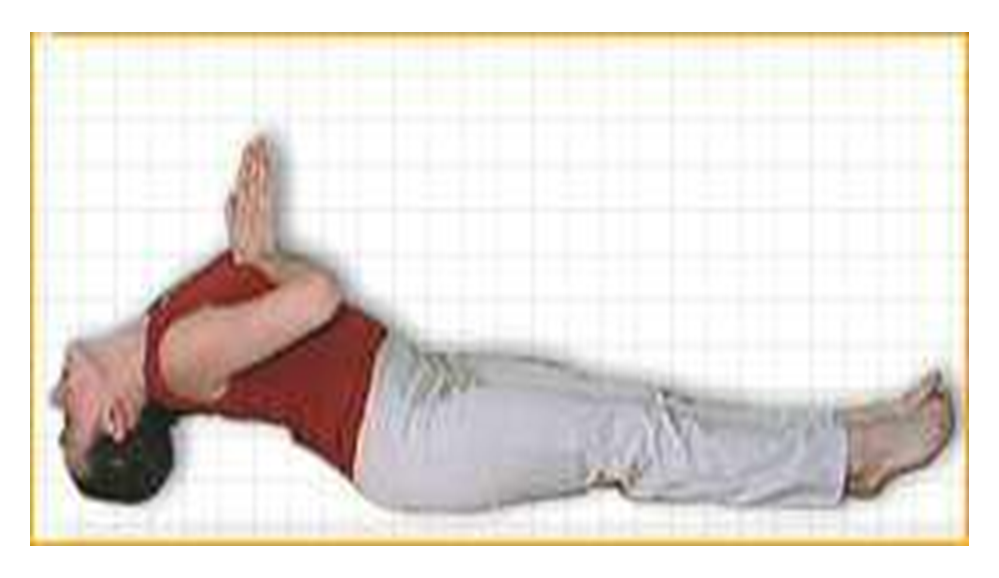
by Neetu | Jun 17, 2020 | Fitness Activity
Posture: Matsya-asana – The Fish Pose
(Pronunciation: maht-see-yah-sa-na)
Description:
The Sanskrit word Matsya means fish, therefore this is the fish posture. Matsya (depicted to the left) is a divine being, found in Hindu mythology, that saved mankind from a universal flood.
Performing Instructions:
- Lie flat on the back in the shava-asana.
- Keeping the buttocks on the floor, inhale and raise the head, shoulders, back, and upper arms off the floor arching the back and raising the chest up. Tilt the head back and place the top of the head flat on the floor.
- Raise the elbows off the floor bring your hands up just below the chest and join them at the palms with the fingers pointing straight up (form the Anjali-mudra or salutation hand gesture). Hold for the duration of the inhale breath or breath gently through the nostrils to remain in the posture longer.
- Return to the shava-asana.
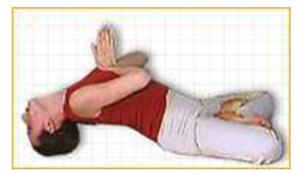
Comments:
The matsya-asana creates a great expansion and stretching of the chest which helps relieve upper respiratory congestion as well as benefits the heart. Additionally, the sinus are drained and opened from the inversion of the head, stretching of the neck and pressure placed on the top of the head. The thyroid and parathyroid glands are stimulated as well.
Duration/Repetitions:
Since this is not a difficult posture, it is recommended that you breathe while holding it for between two and four minutes. If you are uncomfortable breathing, hold the posture for the duration of the inhaled breath. Repeat two or three times.
Variation
There is one major variation in the Matsya-asana and it is a bit more challenging than the one described above (illustrated above). It calls for beginning the posture in Padma-asana or the full lotus seated posture and then lying flat on the back while the legs are still locked. From there on the posture is done the same way as described above.
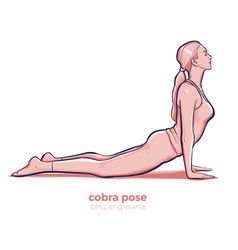
by Neetu | Jun 17, 2020 | Fitness Activity
Posture: Naga-asana – The Cobra Pose
(Pronunciation: na-gah-sa-na)
Description:
The Sanskrit word naga means snake or serpent. The naga-asana is also known as the bhujanga-asana. The Sanskrit word bhujanga, which also means snake, is derived from the root bhuj which means to bend or curve.
“Let the body, from navel to toes, touch the ground, the palms placed upon the ground, and raise gently the upper part of the body (from navel to head) like a snake. This posture increases the gastric fire; it destroys all diseases and by constant practice leads to the awakening of Kundalini.”
Performing Instructions
- Lie on the stomach with the head turned to one side and the arms alongside the body with palms facing upward
- Turn the head and place the chin on the floor. Inhale then exhale slowly through the nostrils and swing the arms around until the hands are placed just below the chin with the palms down and the fingertips of each hand almost touching and the elbows on the floor.
- Inhale slowly through the nostrils, press down on the hands and lift the torso from the waist up off the floor, arching the spine backward and straightening the arms. Keep the hips on the floor.
- Tilt the head as far back as possible and hold the posture for the duration of the inhaled breath.
- Exhale and reverse the process to return to position #1.
Comments:
If you find it uncomfortable holding the breath while the posture is held, breath gently through the nostrils. Some may find that they are able to arch the spine back even more than in the initial arch in step 3. In this case, try “walking” the hands toward the pelvic region and stretching the head further back.
In addition to the obvious benefits to the spine and lower back, the standard variation of the naga-asana strengthens the wrists and stretches the muscles in the chest. By maintaining a constant exertion to create a greater arch in the spine, the stomach and pelvic muscles are strengthened. Greater strength in these areas can be cultivated by performing the variation where the arms remain on the ground. There are claims that displaced spinal discs can be placed back in their original position by practicing the naga-asana.
Duration/Repetitions
Hold the posture for either the duration of a held inhaled breath or from one-half to three minutes. Repeat the naga-asana two to five times.
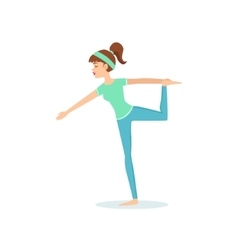
by Neetu | Jun 17, 2020 | Fitness Activity
Posture: Nataraja-asana (The King of the Dance Pose)
(Pronunciation: nah-tah-raj-ah-sa-na)
Description:
The Sanskrit word nata means dancer and raja means king. Nataraja is another name for Shiva, the Lord of the Dance, whose cosmic dance is the creation and destruction of the world.
Performing Instructions:
- Stand with the feet together and the arms by your sides (see the tad-asana).
- Inhale and bend the right leg backward grasping the left foot with your left hand while simultaneously extending the right arm straight out in front.
- Continue raising the right arm upward until it is about 45 degrees from the floor while lifting the left leg as high as possible with the left arm.
- Hold the posture while breathing gently through the nostrils. Keep your gaze fixed slightly above the horizon.
- Remain in the nataraja-asana for about one minute then return slowly to a standing position. Repeat by reversing directions 2-4.
Comments:
Perform the nataraja-asana gracefully as if dancing, yet firmly with focused attention.
This posture helps to strengthen your sense of balance and concentration. The arch formed by the back and stretched leg gently aligns the vertebrae of the spine restoring suppleness and easing strain caused by poor posture or long periods of sitting. It tones the muscles of the hips and legs as well as stimulates the chest muscles.
Duration/Repetitions
Begin by holding the nataraja-asana for about a minute and gradually increase the time as you become more comfortable with this posture. Repeat it three times on each side, alternately from right to left.








